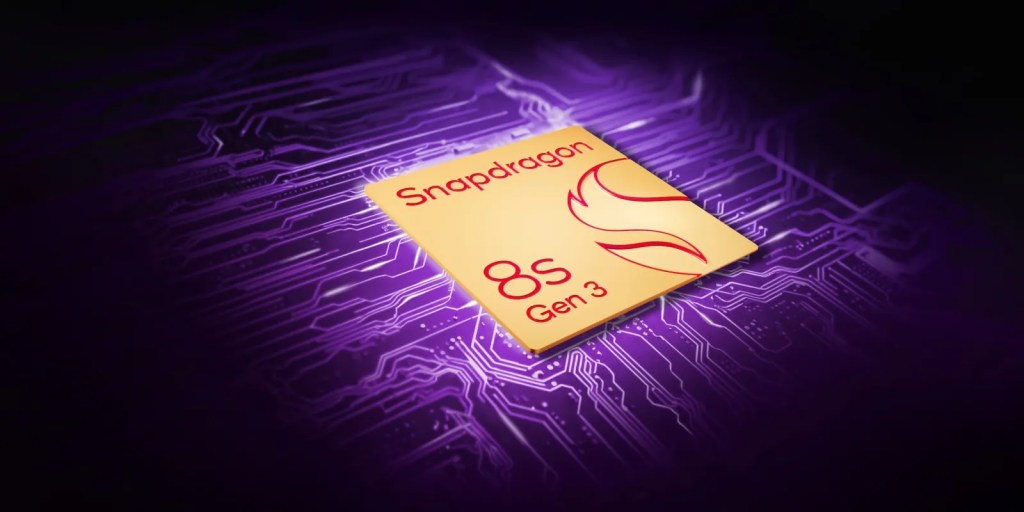Qualcomm chipsets are classified in a number-based hierarchy, with further divisions including “+” and, more recently, “s” models. The Snapdragon 8s Gen 3 chipset, which delivers some of the premium Snapdragon capabilities at a lower price than the flagship 8 Gen 2 and 8 Gen 3 CPUs, was unveiled by the company.
The Cortex-X4 prime core clocked at 3.0GHz, four performance cores at 2.8GHz, and three efficiency cores at 2.0GHz are included in the 4nm 8s Gen 3 processor. It can support UFS 4.0 storage and up to 24GB of LPDDR5x RAM (up to 4,200MHz). It supports USB 3.1 Gen 2 via USB-C for communication.
This is the way it stands about the previous Snapdragon 8 Gen 2 and the Snapdragon 8 Gen 3:
| Snapdragon 8 Gen 2 | Snapdragon 8s Gen 3 | Snapdragon 8 Gen 3 |
Node | TSMC 4nm | TSMC 4nm | TSMC 4nm |
CPU (Prime) | 1x Cortex-X3 @ 3.2/3.36GHz | 1x Cortex-X4 @ 3.0GHz | 1x Cortex-X4 @ 3.3/3.4GHz |
CPU (Big) | 2x Cortex-A715 @ 2.8GHz | 4x Cortex-A720 @ 2.8GHz | 3x Cortex-720 @ 3.15GHz |
CPU (Small) | 3x Cortex-A510 @ 2.0GHz | 3x Cortex-A520 @ 2.0GHz | 2x Cortex-A520 @ 2.3GHz |
RAM | up to 24GB LPDDR5x 4,200MHz | up to 24GB LPDDR5x 4,200MHz | up to 24GB LPDDR5x 4,800MHz |
Storage | UFS 4.0 | UFS 4.0 | UFS 4.0 |
USB | USB 3.1 | USB 3.1 Gen 2 | USB 3.1 Gen 2 |
GPU | Adreno 740 | Adreno 735 | Adreno 750 |
5G modem | X70 | X70 | X75 |
ISP | triple 18-bit | triple 18-bit | triple 18-bit |
Video | 8K HDR @ 30fps | 4K HDR @ 60fps | 8K HDR @ 30fps |
As you can see, this is more than simply an 8 Gen 3 binned version. It contains four large cores and three little cores for a 1+4+3 arrangement, with the Cortex-X4 core running at a slower clock speed. The original 8 Gen 3 chip is set up as 1+5+2.
The Snapdragon X70 5G modem, rather than the X75, is used, and RAM support is more like to that of the 8 Gen 2. Qualcomm asserts that the 8s Gen 3 incorporates 5G power savings and 3GPP Release 17, which the 8 Gen 2 does not. In any case, phones will benefit from more bandwidth and reduced latency as the chip is compatible with the latest Wi-Fi 7 standard. For audio, Auracast and 15-bit 44.1kHz lossless wireless streaming are supported.
Let’s examine the premium features Qualcomm selected for the Snapdragon 8s Gen 3 in more detail.
Since new applications have become quite popular but also bring up new problems, generative AI is leading the way. The most widely used variants, such as Llama 2, Baichuan-7B, and Gemini Nano (which is one of the new difficulties we noted); Pixel 8 customers just discovered that their phones cannot run Gemini Nano—are compatible with the 8s chip. Up to 10 billion parameters can be included in models. Though the model’s on-device AI assistance sets it apart from the earlier 8 Gen 2, it is not as quick on jobs as the 8 Gen 3 can do.
Apart from AI, the new CPU aims to provide flagship gaming performance and a flagship photography experience. Regarding the former, it has a triple 18-bit ISP that collaborates closely with the Hexagon NPU to process images. It activates a function called an “always-sensing camera,” which accelerates QR code scanning and face unlocking. In addition to improving image quality in low light, the ISP+NPU combination can also perform outpainting, or “uncropping” images.
Technically speaking, it can operate a single 108MP camera at 30 frames per second with no shutter latency or three 36MP cameras at 30 frames per second with zero shutter lag. There is a 200MP maximum image capture resolution. 4K HDR films at up to 60 frames per second are compatible with 10-bit HEIC and HEVC photos and videos. Take note that there isn’t an 8K video option or a 4K at 120 frames per second. These are only available on the top-tier 8-series devices.
The Snapdragon 8s Gen 3 (SM8635) has a powerful Adreno GPU for gaming. Hardware-accelerated ray tracing is supported. The Snapdragon Game Super Resolution increases the number of pixels in the picture at no additional expense, while the Adreno Frame Motion Engine 2.0 can double the frame rate without using more power.
The processor can drive a 4K display at 60Hz or an on-board QHD+ display at up to 144Hz. The range of 1Hz to 240Hz is offered for variable refresh rates. Up to 8K panels (30Hz) or 1080p high refresh rate panels (up to 240Hz) can be used as external monitors.
The processor allows for HDR playback (HDR10+, Dolby Vision, HLG) and H.265 and AV1 video decoding (up to 4K at 60 frames per second).
The Snapdragon 8s Gen 3 has already been chosen by several well-known smartphone manufacturers, including Honor, iQOO, Realme, Xiaomi, and Redmis (which will also use this processor). “In the coming months” is when they will make the phone announcement, although we don’t think it will be too lengthy.








